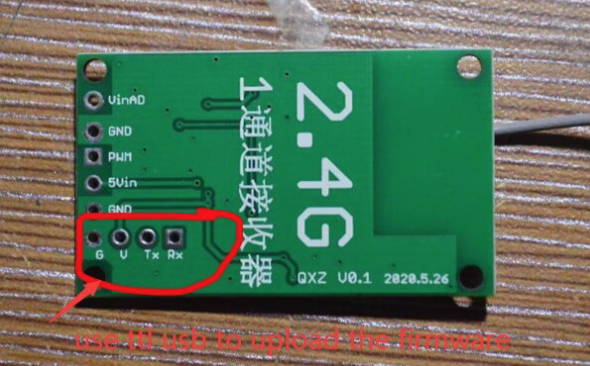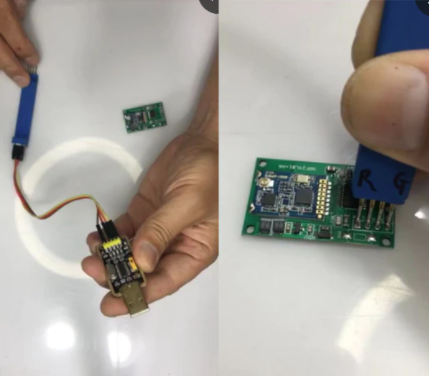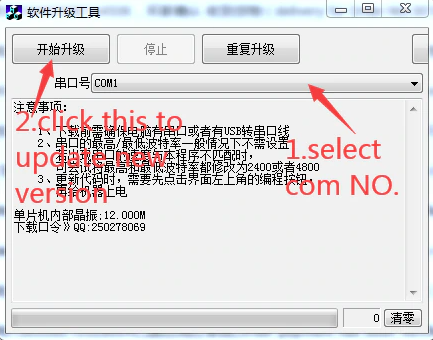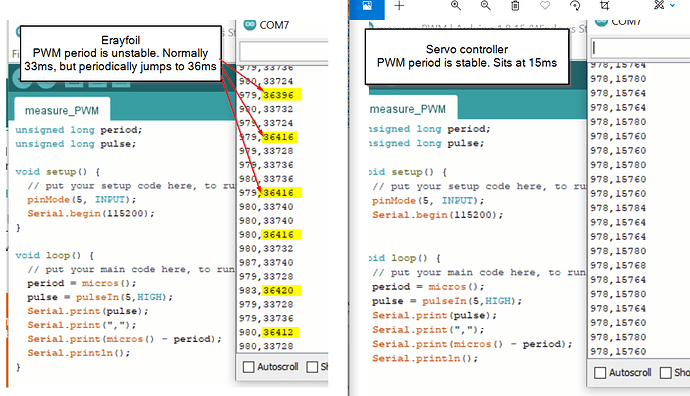No, but bother me that it does not show battery voltage.
You can log data vith vesc app on your phone and look it up after.
Link on where to buy the remote please.
Thanks in advance
HRK 1,067.34 | 1set Erayfoil A1 Waterproof 2.4GHz Remote Controller for Electric Skateboard Longboard Hydrofoil Surfboard Efoil Remote
https://a.aliexpress.com/_mOrXzuJ
Just bought this remote too.
I am using a Seashark ESC, and I’m finding the PWM connection between the receiver and the ESC to be somewhat unreliable. For example if I power on the ESC and then plug in the receiver, the ESC does not start up. (If I do the same with another RC receiver or standard servo tester it works fine).
Have you found any similar issues?
I did some testing, and I found the Erayfoil RC receiver PWM signal is not being outputted at the standard 50Hz.
The specs say the PWM signal should be outputted at 50Hz.

I have contacted the vendor, and so far they have seemed pretty responsive, so we’ll see what they say.
I’m a little worried about putting the 50V line from the main battery right next to these pins. Have you put any protection circuitry in place between the battery and the RC receiver?
Thanks for the tear-down pics by the way! Very handy to know there is good potting and waterproofing in place. Finding a reliable remote has been the bane of my efoil journey.
@mickeyt No I have not. I have a 14s battery and I connected directly to the small pin. What do you think would be an adequate protection circuitry system. Any suggestions would be great.
Yes, the out of the box ready to use, waterproof and Affordable remote has been a very elusive unicorn!
I would suggest an in-line fuse, so if the pins short it doesn’t burn out the wires. You could also add a 10K resistor in line, you’d just need to check the impedance of the voltage divider in the receiver board to check that it doesn’t affect the voltage sensing accuracy.
The other consideration is if you are picking up the receiver with the main battery you could get an electric shock, so I would ensure the receiver board is covered in heatshrink or similar. Probably also putting some silicone or liquid electrical tape over the pins themself as well.
The best design in my opinion is a galvanically isolated voltage sensing module, however these do not seem to be readily available. I have designed one and ordered the parts, but I haven’t got around to building it yet. (Similarly I have also build a galvanic isolation module for the PWM signal from the receiver)
Are any of you aware if it would be possible to activate a water pump with this remote as I can with the Maytech or is it lacking that extra button?
@qzyf @Curlew I do not know the answer to this. I have forced water cooling and do not have a pump. Jay maybe you can answer his question above? Curlew if you write @qzyf maybe he can answer your question?
Thanks Wushbush… @qzyf have you any thoughts on it?
I’ve bought an efoil from my friend @rogjalon &
I need a spare remote. I’ll get this one if it can turn on the pump & if not, another Maytech which will have to be waterproofed as you’re all aware.
One long press on the Maytech side (power) button turns it on & 2 short presses activates the cooling water pump that he’s installed.
The Erayfoil receiver doesn’t appear to have a relay or connection for it, so we don’t think it has that capability.
Thanks for any input
Sorry, this remote control has only one channel, there is no other switch to control the pump
Dump the pump… it adds no value and just adds something more to go wrong. On all my builds my ESC’s have never gone over 36degC with natural flow.
Interesting… I imagine it depends on the arrangement & efficiency of cooling intakes/lines/flow restriction in the cooling circuit etc…
I do agree with @Jezza that force water cooling is a better option. However the aluminium motor pod clamp would have to be modified to take the pipe.
Update on the unreliable PWM issue.
The issue was actually not that the PWM period was 35ms as opposed to 20ms, but that the period was fluctuating.
The manufacturer has supplied a firmware update which has fixed the issue. The PWM frequency is now stable. And there are no issues with the PWM output connection to my ESC.
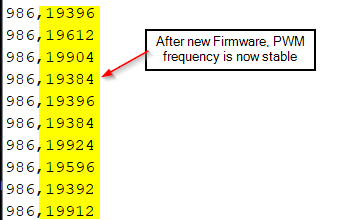
That’s what I call a demonstration.
Thank you for imagining it, implementing it and publishing the Arduino code and result.
I must admit I would be very interested in the cabling and probe position to reproduce it at home.
Would you say this Erayfoil remote in now the best value for money for our use ?
I’m pretty happy with the remote now the PWM issue is fixed. I haven’t tested it for extended periods (I.e. to see how it copes with corrosion and water ingress), but it seems built pretty well. I do wonder how long before the spring in the throttle starts to corrode. I quite like the control / menu / ergonomics. Being able to set the throttle at a fixed amount, and adjust with the plus/minus buttons is also very handy.
I used a $50 waterproof remote before, but I wasn’t a big fan of controlling the throttle with my thumb. The battery connection also failed after a short while. I went down the road of building my own controller, but it was quite a lot of effort for not a very great outcome. I was also considering the Maytech remote but I haven’t tried that one.
I’m not sure how many ESCs would have the same issue with the unstable PWM period. To replicate the arduino setup to measure the PWM period just wire the PWM signal output to the Arduino input pin (and ground to ground). The other thing I forgot to mention was I programmed an Arduino to generate a similar unstable PWM output which reproduced the unreliable ESC connection, so this helped to isolate the cause of the issue.
The new remote are all now upgraded or do you upgrade the firmware yourself ?
You had better check with the manufacturer if the remote now includes the new firmware. Ask for the “50Hz PWM Output” firmware.
I upgraded the firmware myself following instructions from manufacturer (included below)
